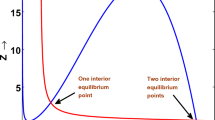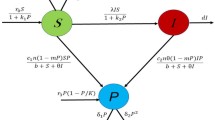Abstract
Armstrong and McGehee (1980) have shown that two species modeled in continuous time can coexist on a single resource provided that one species oscillates autonomously. This paper demonstrates the parallel result in discrete time. I consider a deterministic model of two asexual types in a single patch competing for a single resource, and show that such systems generically produce oscillatory coexistence or bistability if one of the types displays periodic or chaotic behavior in isolation. The conditions for coexistence or bistability are derived in terms of the convexity of the functions describing fitness as a function of resource availability. I also analyze whether or not a stable type, a type with a stable equilibrium population size when considered in isolation, can invade a periodic orbit of an unstable type, and show that the same convexity condition distinguishes these two cases. The widely considered exponential or Ricker model for population dynamics lies on the boundary between the two cases and is highly degenerate in this context.
Similar content being viewed by others
References
Armstrong, R. A., McGehee, R.: Coexistence of species competing for shared resources. Theor. Popul. Biol. 9, 471–486 (1976)
Armstrong, R. A., McGehee, R.: Competitive exclusion. Am. Nat. 115, 151–170 (1980)
Asmussen, M. A., Feldman, M.: Density-dependent selection I: A stable feasible equilibrium may not be attainable. J. Theor. Biol. 64, 603–618 (1977)
Billingsley, P.: Probability and measure. New York: Wiley 1986
Chesson, P. L.: Environmental variability and the coexistence of species. In: Case, T., Diamond, J. (eds.) Community ecology, pp. 240–256. New York: Harper and Row 1986
Christiansen, F. B.: Frequency dependence and competition. Phil. Trans. R. Soc. Lond. B319, 587–600 (1988)
Collet, P., Eckmann, J.-P.: Iterated maps on the interval as dynamical systems. Boston: Birkhäuser 1986
Crow, J. F., Kimura, M.: An introduction to population genetics theory. New York: Harper and Row 1970
Cushing, J.: Two species competition in a periodic environment. J. Math. Biol. 10, 385–400 (1980)
Cushing, J., Li, J.: On Ebenman's model for the dynamics of a population with competing juveniles and adults. Bull. Math. Biol. 51, 687–713 (1989)
de Mottoni, P., Schiaffino, A.: Competition systems with periodic coefficients: a geometric approach. J. Math. Biol. 11, 319–335 (1981)
Hadeler, K. P., Gerstman, I.: The discrete Rosenzweig model. Math. BioSci. 98, 49–72 (1990)
Hassell, M., Lawton, J. H., May, R. M.: Patterns of dynamical behaviour in single-species populations. J. Anim. Ecol. 45, 471–486 (1976)
Iwasa, Y., Teramoto, E.: A criterion of life history evolution based on density dependent selection. J. Theor. Biol. 84, 545–566 (1980)
John, F.: Partial differential equations. New York: Springer 1986
Kaplan, W.: Advanced calculus. New York: Addison-Wesley 1973
Levin, S. A.: Community equilibria and stability, and an extension of the competitive exclusion principle. Am. Nat. 104, 413–423 (1970)
Levin, S. A., Levin, J. E., Paine, R. T.: Snowy owl predation on short-eared owls. The Condor 79, 395 (1977)
May, R. M.: Simple mathematical models with very complicated dynamics. Nature 261, 459–467 (1976)
Maynard Smith, J., Harper, D. G. C.: The evolution of aggression: can selection generate variability? Philos. Trans. R. Soc. Lond., B319, 557–571 (1988)
Paine, R. T., Levin, S. A.: Disturbance, patch formation, and community structure. Proc. Nat. Acad. Sci. 71, 2744–2747 (1974)
Poulsen, E. T.: A model for population regulation with density and frequency-dependent selection. J. Math. Biol. 8, 325–343 (1979)
Roughgarden, J.: Density-dependent natural selection. Ecology 52, 453–468 (1971)
Roughgarden, J.: Theory of population genetics and evolutionary ecology. New York: Macmillan 1979
Selgrade, J. F., Namkoong, G.: Stable periodic solutions for two species, density dependent coevolution. J. Math. Biol. 22, 69–80 (1985)
Slatkin, M., Wilson, D. S.: Coevolution in structured demes. Proc. Nat. Acad. Sci. 76, 2084–2987 (1979)
Author information
Authors and Affiliations
Rights and permissions
About this article
Cite this article
Adler, F.R. Coexistence of two types on a single resource in discrete time. J. Math. Biol. 28, 695–713 (1990). https://doi.org/10.1007/BF00160232
Received:
Revised:
Issue Date:
DOI: https://doi.org/10.1007/BF00160232




